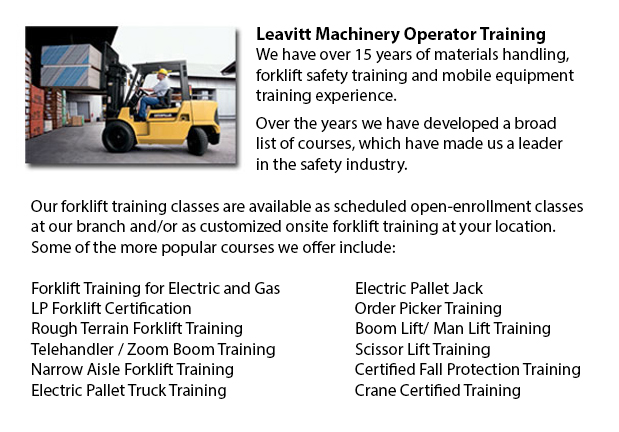
Saskatoon Forklift Training Schools - Why Individuals Who Utilize A Forklift Should Take Whatever Of Our Forklift Training Schools
Are you looking for a job as a forklift driver? Our regulatory-compliant mobile equipment operator training provides instruction in types of lift trucks, pre-shift inspection, fuel kinds and handling of fuels, and safe utilization of a forklift. Hands-on, practical training helps individuals participating in obtaining basic operational skills. Program content covers existing rules governing the utilization of forklifts. Our proven forklift courses are designed to provide training on these kinds of trucks: counterbalanced forklift, powered pallet trucks and narrow isle forklift.
When the lift truck is in operation, do not lower or raise the forks. Loads should not extend above the backrest. This is due to the possibility of the load sliding back in the direction of the operator. Check for overhead obstructions and make certain there is enough clearance prior to raising a load. Stay away from overhead power lines. Once the load is lifted straight up, tilt it back slightly.
The lift truck is less stable if a load is in a raised position. Make certain that no one ever walks underneath the elevated fork. The operator must never leave the lift truck when the load is lifted.
The forks should be level when handling pallets, and high enough to extend all the way into and beneath the load. The fork's width must provide even distribution of weight.
Before loading or unloading the truck, chock the wheels and set the brakes. Floors must be strong enough to support the weight of the forklift and the load combined. Fixed jacks can be installed to support a semi-trailer which is not coupled to a tractor. The height of the entrance door should clear the forklift height by a minimum of 5 cm. Edges of docks, rail cars and ramps should be marked and avoid them.
-
Saskatoon Telehandler License
Saskatoon Telehandler License - The telescopic handler or telehandler is a frequently utilized machine in agricultural and industrial applications. This particular equipment is similar in appearance to a forklift and even functions in a similar way,... More -
Saskatoon Zoom Boom Ticket
Saskatoon Zoom Boom Ticket - Zoom Boom Training focuses on correctly training prospective operators on variable reach forklifts. The training objectives consist of gaining the knowledge of the machine's physics and to define the job of the operator.... More -
Saskatoon Forklift Operator Training
Saskatoon Forklift Operator Training - In North America, lift truck operator training is needed in order to prevent workplace injuries and accidents. Particular lift truck training will be provided to offer forklift operators driver training. The saf... More -
Saskatoon Forklift Certification Schools
Saskatoon Forklift Certification Schools - Forklift Certification is mandatory in North America. Hence, forklift training programs are essential both for businesses and for individuals seeking jobs in industries as forklift operators. Forklift traini... More -
Saskatoon Telehandler Training Courses
Saskatoon Telehandler Training Courses - Employers are responsible for making certain that their operating personnel and supervisors are trained to work competently utilizing telehandler machines. The competence level of staff must be assessed. If de... More -
Saskatoon Boom Lift Training
Saskatoon Boom Lift Training - Aerial platforms or likewise known as elevated work platforms are devices that enable workers to perform tasks and duties at elevated heights that will not be otherwise accessible. There are many aerial lifts available... More -
Crane / Overhead Crane / Self-Erect Crane / Truck Mounted Crane / Hydraulic Cranes Training in Saskatoon
Overhead cranes are likewise referred to as bridge cranes. They are a type of crane which comprises a line and hook device that runs along a horizontal beam which runs along two widely separated rails. Several overhead cranes can be found within a lo... More -
Saskatoon Heavy Equipment Training Programs
Saskatoon Heavy Equipment Training Programs - At any given construction site, there are usually different types of machinery which are ready to be used. These light and heavy machinery require both operators to run them and mechanics to fix them. Tra... More

Forklift Certification Saskatoon
TOLL FREE: 1-888-254-6157
Saskatoon, Saskatchewan
forkliftcertificationsaskatoon.com
Email Us
About Us


